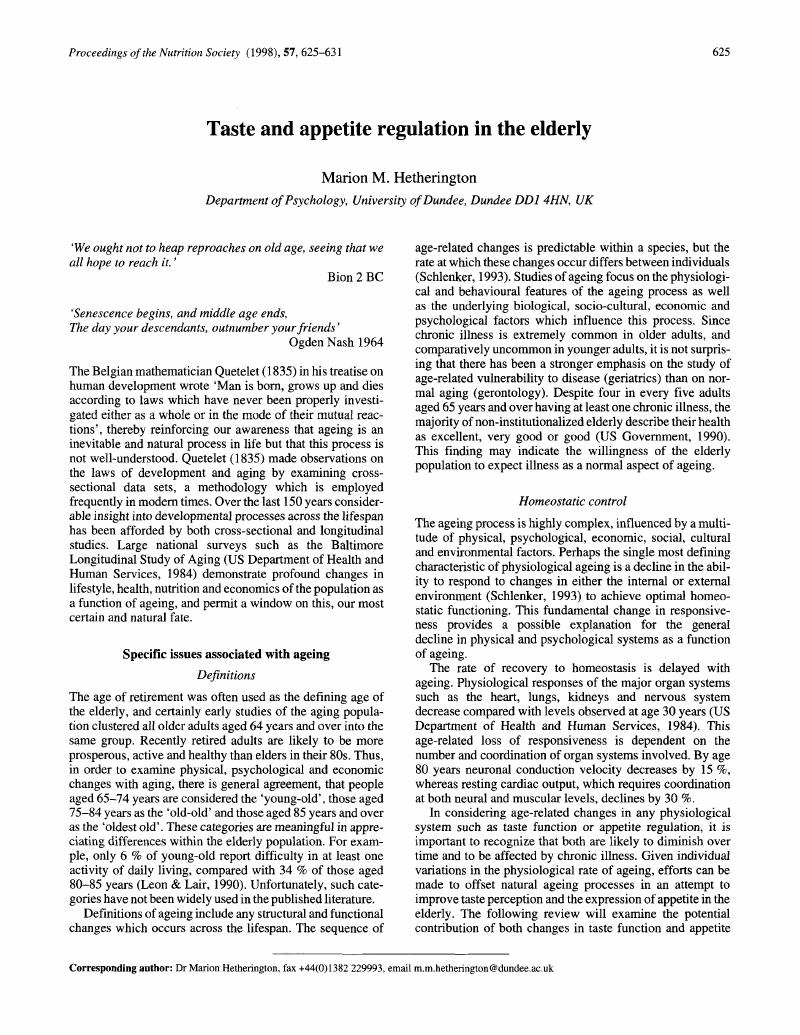Crossref Citations
This article has been cited by the following publications. This list is generated based on data provided by Crossref.
Morley, J. E.
2001.
Decreased Food Intake With Aging.
The Journals of Gerontology Series A: Biological Sciences and Medical Sciences,
Vol. 56,
Issue. Supplement 2,
p.
81.
Mathey, M.-F. A.M.
Siebelink, E.
de Graaf, C.
and
Van Staveren, W. A.
2001.
Flavor Enhancement of Food Improves Dietary Intake and Nutritional Status of Elderly Nursing Home Residents.
The Journals of Gerontology Series A: Biological Sciences and Medical Sciences,
Vol. 56,
Issue. 4,
p.
M200.
Henry, C. Jeya K.
Woo, Jean
Lightowler, Helen J.
Yip, Ricky
Lee, Roselle
Hui, Elsie
Shing, Sandra
and
Seyoum, Teodros A.
2003.
Use of natural food flavours to increase food and nutrient intakes in hospitalized elderly in Hong Kong.
International Journal of Food Sciences and Nutrition,
Vol. 54,
Issue. 4,
p.
321.
Wikby, Kerstin
and
Fägerskiöld, Astrid
2004.
The willingness to eat.
Scandinavian Journal of Caring Sciences,
Vol. 18,
Issue. 2,
p.
120.
Hughes, Georgina
Bennett, Kate M.
and
Hetherington, Marion M.
2004.
Old and alone: barriers to healthy eating in older men living on their own.
Appetite,
Vol. 43,
Issue. 3,
p.
269.
Macht, Michael
Meininger, Jessica
and
Roth, Jochen
2005.
The Pleasures of Eating: A Qualitative Analysis.
Journal of Happiness Studies,
Vol. 6,
Issue. 2,
p.
137.
Koskinen, Sari
and
Tuorila, Hely
2005.
Performance on an odor detection and identification test as a predictor of ortho- and retronasal odor intensity ratings in the young and elderly.
Food Quality and Preference,
Vol. 16,
Issue. 5,
p.
383.
Seo, Sunhee
and
Shanklin, Carol W.
2005.
Important Food and Service Quality Attributes of Dining Service in Continuing Care Retirement Communities.
Journal of Foodservice Business Research,
Vol. 8,
Issue. 4,
p.
69.
Koskinen, Sari
Nenonen, Aino
and
Tuorila, Hely
2005.
Intakes of cold cuts in the elderly are predicted by olfaction and mood, but not by flavor type or intensity of the products.
Physiology & Behavior,
Vol. 85,
Issue. 3,
p.
314.
Woodside, Jayne V
and
Young, Ian S
2006.
Nutrition and the Eye.
p.
133.
Hays, Nicholas P.
and
Roberts, Susan B.
2006.
The anorexia of aging in humans.
Physiology & Behavior,
Vol. 88,
Issue. 3,
p.
257.
Hickson, M
2006.
Malnutrition and ageing.
Postgraduate Medical Journal,
Vol. 82,
Issue. 963,
p.
2.
Appleton, Katherine M.
2009.
Increases in energy, protein and fat intake following the addition of sauce to an older person’s meal.
Appetite,
Vol. 52,
Issue. 1,
p.
161.
Nieuwenhuizen, Willem F.
Weenen, Hugo
Rigby, Paul
and
Hetherington, Marion M.
2010.
Older adults and patients in need of nutritional support: Review of current treatment options and factors influencing nutritional intake.
Clinical Nutrition,
Vol. 29,
Issue. 2,
p.
160.
Mavrommatis, Yiannis
Moynihan, Paula J.
Gosney, Margot A.
and
Methven, Lisa
2011.
Hospital catering systems and their impact on the sensorial profile of foods provided to older patients in the UK.
Appetite,
Vol. 57,
Issue. 1,
p.
14.
Galindo, María Mercedes
Schneider, Nanette Yvette
Stähler, Frauke
Töle, Jonas
and
Meyerhof, Wolfgang
2012.
Recent Advances in Nutrigenetics and Nutrigenomics.
Vol. 108,
Issue. ,
p.
383.
Appleton, K. M.
2013.
Increases in fruit intakes in older low consumers of fruit following two community-based repeated exposure interventions.
British Journal of Nutrition,
Vol. 109,
Issue. 5,
p.
795.
Kremer, Stefanie
Holthuysen, Nancy
and
Boesveldt, Sanne
2014.
The influence of olfactory impairment in vital, independently living older persons on their eating behaviour and food liking.
Food Quality and Preference,
Vol. 38,
Issue. ,
p.
30.
Huang, Yi-Chen
Wahlqvist, Mark L.
and
Lee, Meei-Shyuan
2014.
Appetite predicts mortality in free-living older adults in association with dietary diversity. A NAHSIT cohort study.
Appetite,
Vol. 83,
Issue. ,
p.
89.
Appleton, K.
2016.
Barriers to and Facilitators of the Consumption of Animal-Based Protein-Rich Foods in Older Adults.
Nutrients,
Vol. 8,
Issue. 4,
p.
187.



